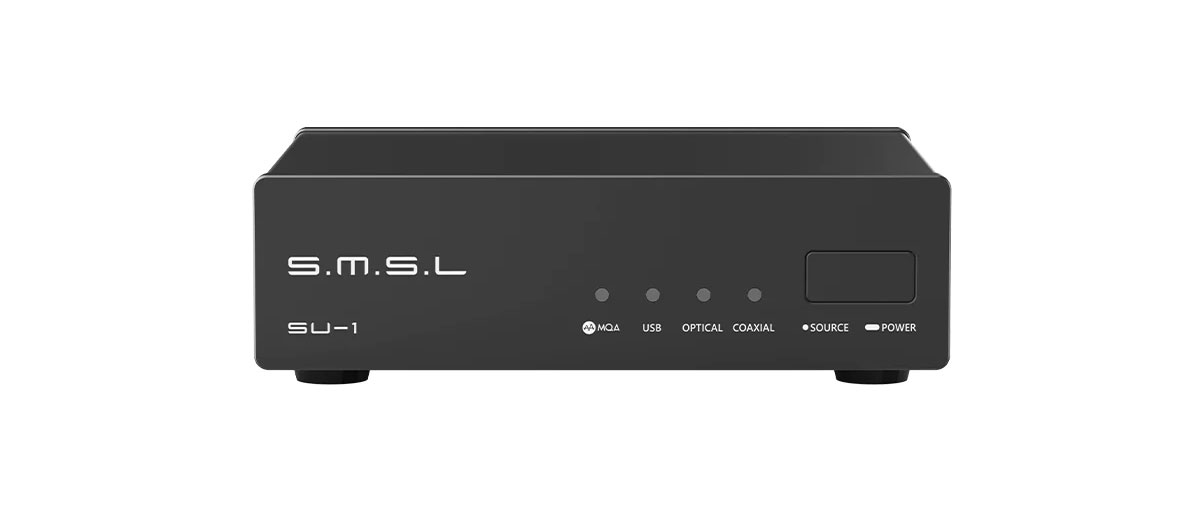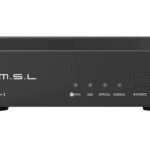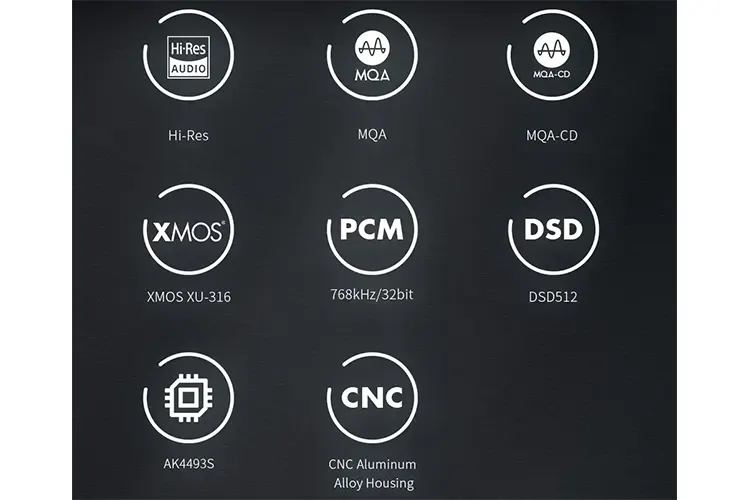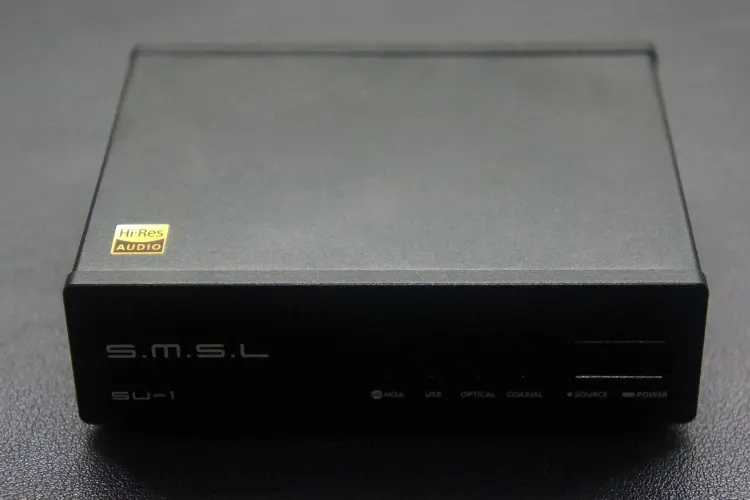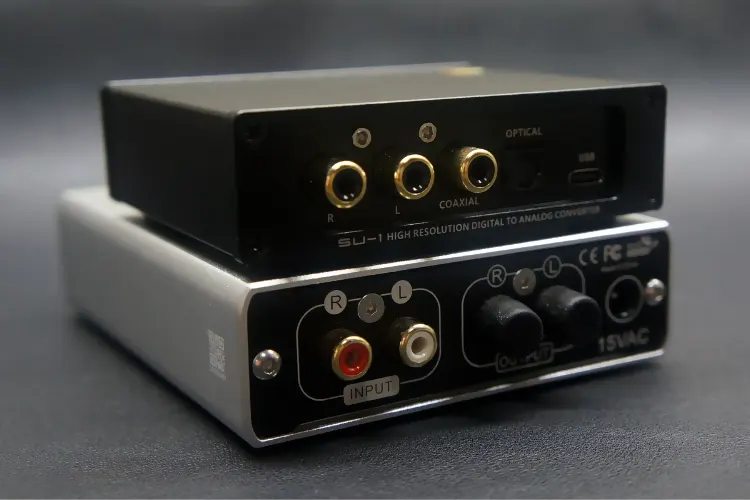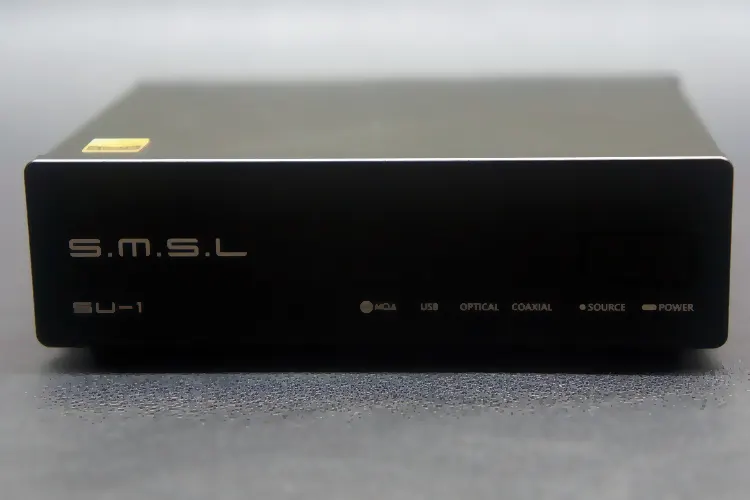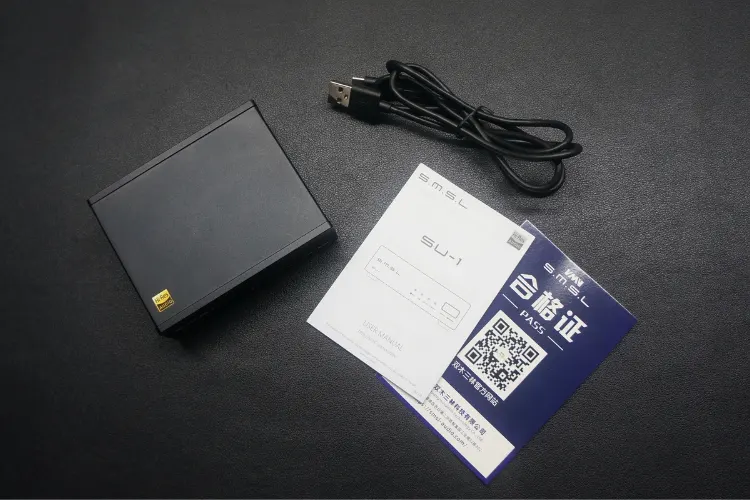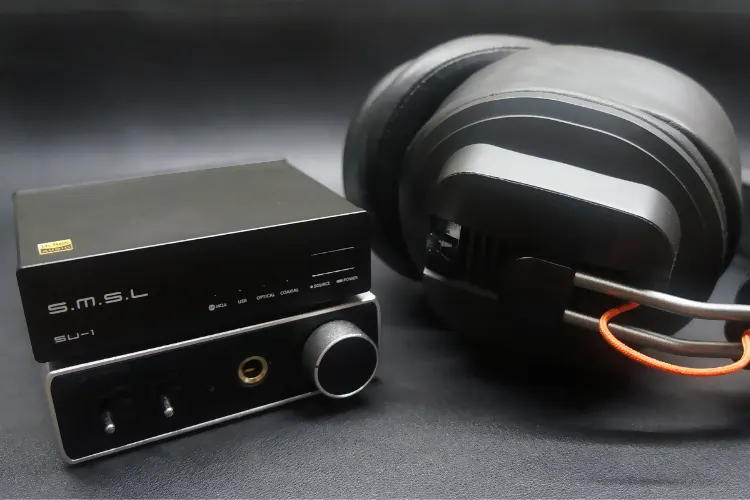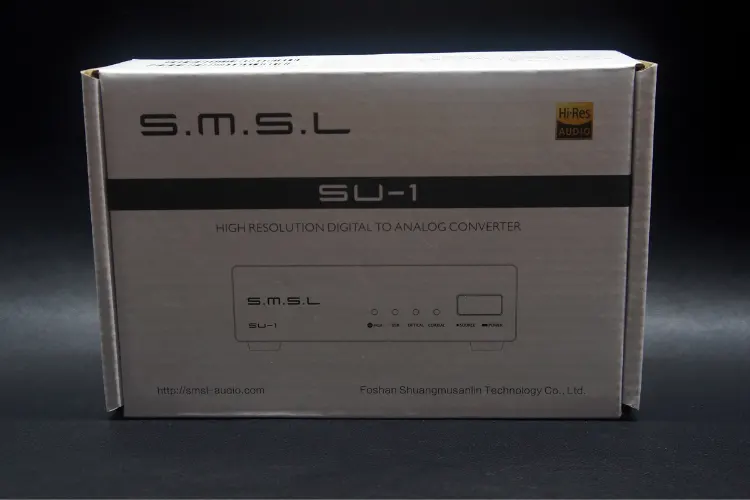Today, we review the SMSL SU-1, which is an entry-level MQA-capable single-ended desktop digital audio decoder using an AK4493S DAC. It is priced at $79.99.
Disclaimer: This sample was sent to us for our honest opinion. Headfonics is an independent website with no affiliate links or partnerships. We thank Shenzhen Audio and SMSL for their support.
Click here to learn more about SMSL products that we have previously featured on Headfonics.
Note, that this 2-page article follows our latest scoring guidelines which you can find in more detail here.
SMSL is quite known for cranking out multiple product lines that cover a wide range of audiophile needs. That includes amplifiers and DACs such as the HO100 and the DO100, and higher-end DAC AMP combo units such as the SH-9 Pro and the M500 MKII.
Their latest release, the SU-1, is probably their most affordable stand-alone desktop DAC that we have reviewed to date priced at just $80.
Making use of the AKM AK4493S DAC chip, whilst integrating MQA and MQA-CD decoding support, it certainly has a very interesting value proposition, so let’s see if this unassuming little box has what it takes to punch above its weight class.
Tech Highlights
The SU-1 supports MQA (Master Quality Authenticated) decoding technology, delivering high-fidelity in a smaller file size.
Regardless of where you stand on the MQA argument, it’s hard to deny the fact that MQA decoding is rarely seen in DACs at this price range. Additionally, SU-1 can also decode MQA-CDs, which are CDs that contain MQA-encoded files.
The SU-1 uses a third-generation XMOS XU-316 processor, providing a stable and low-latency USB connection. The XMOS chip works in unison with an AKM AK4493S DAC chip, letting it decode PCM 32-bit/768kHz and DSD512 formats.
Lastly, the SU-1 is encased in a CNC-machined aluminum alloy housing. The housing also has an anodized finish with nicely chamfered edges, giving it a premium stealthy aesthetic.
Design
The first thing that stands out upon seeing the SU-1 for the first time is its diminutive size. Despite being a DAC meant to be used in one’s desk or home Hi-Fi setup, one could be fooled into thinking it’s a portable class unit.
Upon closer inspection, the four rubber feet at the bottom of the device indicate the true use case of the unit. The entire body is constructed of CNC-machined aluminum with a sleek anodized black finish. The unit does not stand out whatsoever and fits in stealthily in any desktop headphone setup or Hi-Fi setup.
The front of the unit has the SMSL logo as well as the SU-1 branding towards the left of the faceplate. Towards the right, there are four indicator LEDs, 3 for the unit’s multiple input option, and an additional LED that acts as the MQA indicator.
Towards the right of the LEDs is a button that acts as both the power and source selector. The button itself is wide and is ever so slightly indented relative to the face plate, giving it an unobstructed silhouette.
The unit itself is extremely lightweight, however, the rubber feet do a good job of keeping the unit planted even when connected via heavy RCA cables.
I/O
Despite the unit’s barebones utilitarian design, it does not skimp out when it comes to its input options. The unit sports a USB-C input jack that carries both power and data (only when in USB mode), a Toslink optical input, as well as a Coaxial digital input.
This is an impressive suite of inputs especially at a sub-100 USD price point, enabling this DAC to be a hub of a system with multiple digital sources such as streamers, computers, and CD players.
While we’re on the topic of CD players, it would also be important to note that the SU-1 is also capable of decoding MQA CDs, ensuring that audiophiles that are invested in the CD format, as well as the MQA standard seen in the Tidal streaming service, are sufficiently covered.
The USB input on the back panel supports Windows 7/8/8.1/10/11 once the automatic installation of the drivers concludes, as well as Mac OS X10.6+, Linux (driverless), Android, and iOS devices.
The USB input can handle PCM 32-bit/768kHz and DSD512 formats, as well as the previously mentioned MQA and MQA-CD decoding.
Controls
The SU-1 has a simple and intuitive control system, with only one button on the front panel: the power switch. The power switch can be used to turn on/off the device when held, whilst pressing it briefly cycles through the three input sources.
The slight indentation of the power button, in conjunction with source indicator LEDs, makes the unit easy to use even in a dimly lit room.
It is important to note that some listings for the unit, and even some of SMSL’s own marketing material, indicate that it might come with remote control. The unit received by Headfonics had no included remote control, and we are inclined to believe that all retail units do not include a remote control as well.
This is quite a shame since having an included remote would have made the unit perfect for simple two-channel TV or home theater setups, acting as a bridge between a smart TV and a pair of active studio monitors.
Packaging & Accessories
The SU-1 comes in a simple white cardboard box with the SMSL logo on the front. Inside the box, there is a foam insert that holds the device securely, as well as a thin sheet of foam protecting the top of the unit.
Despite the barebones aesthetic of the box, the density and tolerances of the foam packing used were confidence-inspiring, assuring customers that the DAC sat firmly in place throughout shipping.
The box also contains a USB-C to USB-A cable, a user manual (in both English and Chinese), and a warranty card. It is important to highlight the omission of a 5V USB-A adaptor, meaning users who intend to primarily use the optical or coaxial inputs of the DAC must supply their own adaptor to use with the included cable.
Sound Impressions
Summary
The SU-1 is a neutral-sounding DAC that some may even consider “clinical-sounding”. It is well-extended with a good dynamic range, presenting complicated arrangements with no vagueness whatsoever.
Despite this, the unit has average staging performance alongside above-average imaging performance. Its neutral tonality makes it pair well with neutral-sounding amps.
Timbre
The SU-1 has a clean and neutral timbre that does not color the overall tonal balance at all, It does not add any warmth or brightness to the sound but rather preserves its original tonality.
Low-end bass drum hits are not given any additional weight and bass riffs do not bleed into the lower mids. Deep male vocals may sound a bit hollow compared to other warmer DACs.
The mid-range was flat and neutral as well, leaning ever so slightly to the bright side. String instruments are well articulated and textured, and vocal performances are presented in a way that maintains all nuance.
High-pitched female vocals are presented with a slight sparkle, giving a better sense of detail. The treble region is presented in a very detailed manner. Different cymbal strikes can be easily differentiated from one another, but it does not introduce any sibilance in its presentation.
Staging & Dynamics
The SU-1 has an impressive dynamic range, especially for the price point. As I will touch upon later in the interview, the first thing that stood out once I started using the SU-1 was how much less compressed the mixes sounded.
This improvement is better observed in tracks with complex arrangements and multiple layers. Other less capable DACs may present different layers in a way that makes them sound like a solid wall of sound, but the SU-1 makes each layer easily distinguishable from the other.
The SU-1 staging performance is quite average, it doesn’t extend a headphone’s soundstage beyond what it is capable of, but I have also observed wider soundstage performance from other DACs.
It has accurate imaging and positioning that place the instruments and vocal locations precisely in the space. There is no sense of vagueness and individual instruments can be easily isolated.
Synergy
Pairings
Based on my testing, the DAC pairs best with an amplifier with a similarly clean and unadulterated tonality. We found that it pairs well with amplifiers such as the Topping L30 II. The DAC enhances the already clean presentation of the amp, whilst ensuring a strong enough power output even for demanding planar magnetic headphones.
I enjoyed the SU-1 and L30 II combo with the Modhouse T50rRP Argon MK3. Being a warm-sounding headphone, I prefer DACs that do not go beyond or alter the coloration introduced by the headphones.
Select Comparisons
iFi Audio ZEN DAC V1
$129.99
Technical
The SMSL SU-1 features the AKM AK4493S DAC chip supporting PCM up to 32-bit/768kHz and DSD512, in addition to supporting MQA decoding, whilst the iFi Audio ZEN DAC V1 features a Burr-Brown True Native chipset that supports PCM and DXD up to 32-bit/384kHz, and DSD256.
As a DAC/AMP combo, the iFi ZEN DAC is inherently more feature-rich than the SU-1. Since it comes built-in with an amplifier as well, the ZEN DAC also comes with a 6.35mm SE out, as well as a balanced 4.4 Pentaconn output.
For the sake of this comparison however, we will be neglecting the amplifier performance of the ZEN DAC and comparing it strictly as a DAC via its RCA outputs with its output mode set to fixed.
The ZEN Dac only has a sole USB-B input connector, compared to the three inputs present in the SMSL SU-1. Both units are powered via USB, however, the ZEN can also be powered with an optional 5V barrel jack.
Design
The SMSL SU-1 has a CNC-machined aluminum alloy housing with a black anodized finish. This, in conjunction with its use of small dimly lit LEDs, small size, and chamfered boxy design makes it an unassuming device that could, frankly, be easily overlooked when looking at an entire system.
The iFi Audio Zen DAC V1 on the other hand has a sleek trapezoidal aluminum chassis with curved edges and a smooth volume knob on the brushed front panel. The ZEN’s unique shape and two-tone color scheme make it stand out compared to most Hi-Fi equipment, and its inclusion of a large knob makes it more eye-catching than the SU-1.
Performance
When comparing strictly the DAC performance of the two DACs by connecting them to the same amplifier and pair of headphones, the first thing that stands out is how much warmer sounding the ZEN DAC is.
The ZEN emphasizes deep bass hits more than the SU-1, but it gives bass strums significantly more body and makes deep male vocals sound thick and velvety.
When paired with the Argons, the added warmth of the ZEN was a bit overwhelming and came off as too warm but switching to the SU-1 remedied this.
In comparison, the SU-1 sounded more balanced and neutral, and the dynamic range was improved as well. The individual audio tracks that make up a song were easily distinguishable, whereas they sounded somewhat mushed together when using the ZEN DAC.
Our Verdict
As a sub-$100 dedicated DAC, the SMSL SU-1 is hard to beat. Considering its input flexibility, clean implementation of the AKAK4493S DAC, and good dynamics, this could be a perfect upgrade or starter DAC for audiophiles assembling their first desktop audio stack.
It isn’t perfect, it may come off as too clinical for a few, and the omission of a remote control (especially given the conflicting marketing information) holds back the SU-1’s potential as a TV Hi-Fi unit.
That said, for $80, the sonic performance of this little DAC is well worth its asking price.
SMSL SU-1 Technical Specifications
- DAC/AMP Chip: AK4493
- Input(s): Input: USB, Coax, Optical
- Playback USB: 32bit/768kHz, DSD512, MQA, MQA CD
- Playback Coax/Opt: 24bit/192kHz
- THD+N 0.00013% (-117dB)
- SNR: 121dB

